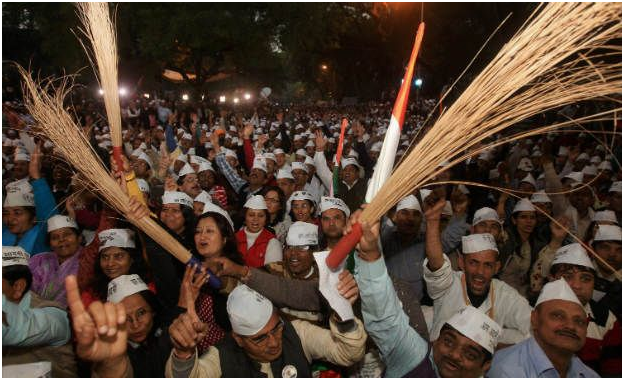SHOCK AND AWE !!
The jhadu beat BJP
NEW DELHI: The Modi wave has broken on Delhi’s shoreline. As it recedes, it leaves behind a ruling party whose reverie of unending years in power has been rudely interrupted and a supreme leader suddenly vulnerable to searching questions from within.
Those questions had begun to be asked from outside but a sense of shock and awe from Modi’s electoral sweep of May 2014 remained. With its dramatic sweep of the Delhi state assembly elections, the Aam Aadmi Party (AAP) dispels that pall of silence. Normalcy has been restored to politics and the technocratic dream of development that the BJP sold to cover up its hard sectarian political identity, stands exposed as an unimaginative fantasy.
What should have been a solid sixty seat triumph if the voting pattern of last year’s Lok Sabha election had persisted, has become a rout for the BJP which has failed to reach double digits in a seventy member assembly. Lofty silence, which has been Prime Minister Narendra Modi’s preferred recourse so far, is now no option. His authoritarian disregard for party and cabinet colleagues, his intent to go his own way and subtly coerce everybody else into line, his anxiety to secure global approval while maintaining an enigmatic silence on actions and statements within the flock that led to serious worries about the directions the country was embarked upon: all these would now come under deeper scrutiny.
Propelled by a powerful propaganda apparatus, Modi showed the energy through his “maximum campaign” last year, to sell a grandiose dream to the electorate. He now has to summon up the order of political skills he is yet to display, to address complexities on the arena of national politics, rather than the simpler milieu of Gujarat.
For the Congress which has literally been decimated after three consecutive terms in power in the National Capital Territory (NCT), the challenge is becoming progressively more difficult. History shows that once it slips into third place in any state, it rarely manages to claw its way back to political relevance. The plaintive cries now being heard for inducting Priyanka Gandhi into the top leadership, only compound the party’s crisis of public credibility.
The Congress oversaw a transformation of the city and its environs in demographic and infrastructural terms. It may then have fallen victim to its own conceit that it had secured a lockhold over Delhi’s ambitions, that demography indeed had changed so radically that traditional BJP constituencies where it saw its main challenge, were thoroughly marginalised. But there were thwarted aspirations just beneath the veneer and a real sense of deprivation and economic disenfranchisement among the masses of working people who kept the city running. In the event, it took an insurgent campaign to tap into these hidden veins.
AAP’s campaign began in scattershot displays of anger against the established order but was then transformed into an organised effort to change things. The anti-establishment message could take it some distance but had to be enhanced with a positive message to ensure a shift of established political loyalties. This the AAP ensured through an agitation programme in some of Delhi’s least affluent areas, focused on improved delivery of basic needs. Then followed the real organisational effort propelled by the cadre of young and highly-skilled political activists that Arvind Kejriwal managed to rally to the cause.
The AAP sweep in Delhi promises to energise politics in far corners of the country. Parties of the left had for the first time in years, coordinated their efforts in the Delhi elections. It was always a losing hand and in a final gesture, the left parties had issued a directive that AAP should be the party of choice for the faithful in constituencies where they were not in play. Curiously, arch rival Mamta Banerjee from distant West Bengal issued an identical directive: that AAP should be the preferred choice of the Delhi voter who set any store by her word.
The Delhi outcome also comes at the same time that the disjointed fragments of the old Janata Dal – Lohia socialists and agrarian populists – seek unity to beat back the BJP juggernaut. There is a degree of purpose evident in a rather dubious cause: evicting the dalit chief minister of Bihar, Jitan Ram Manjhi, so that Nitish Kumar can reclaim the office for his coalition of OBCs. The BJP, which briefly sought to stay out of these factional enmities, has plunged in with unseemly enthusiasm to manipulate numbers in the Bihar legislative assembly, further eroding its public credibility.
Finally, the AAP sweep in Delhi represents the promise of an exciting new brand of politics, which goes beyond the tired clichés of the past and points towards a future of exciting possibilities. Through a bruising campaign, with its fair share of dirty tricks and political innuendo, AAP spokespersons showed a rare persistence in maintaining a certain candour and humility in the public discourse. The BJP and the Congress, unable to see the shift in the mood, kept up a steady barrage of insults of the public intelligence. They now confront the harsh consequences of their purblindness. And other parts of the country gaze towards Delhi in the hope that the AAP brand of politics could sprout and flourish more widely.





